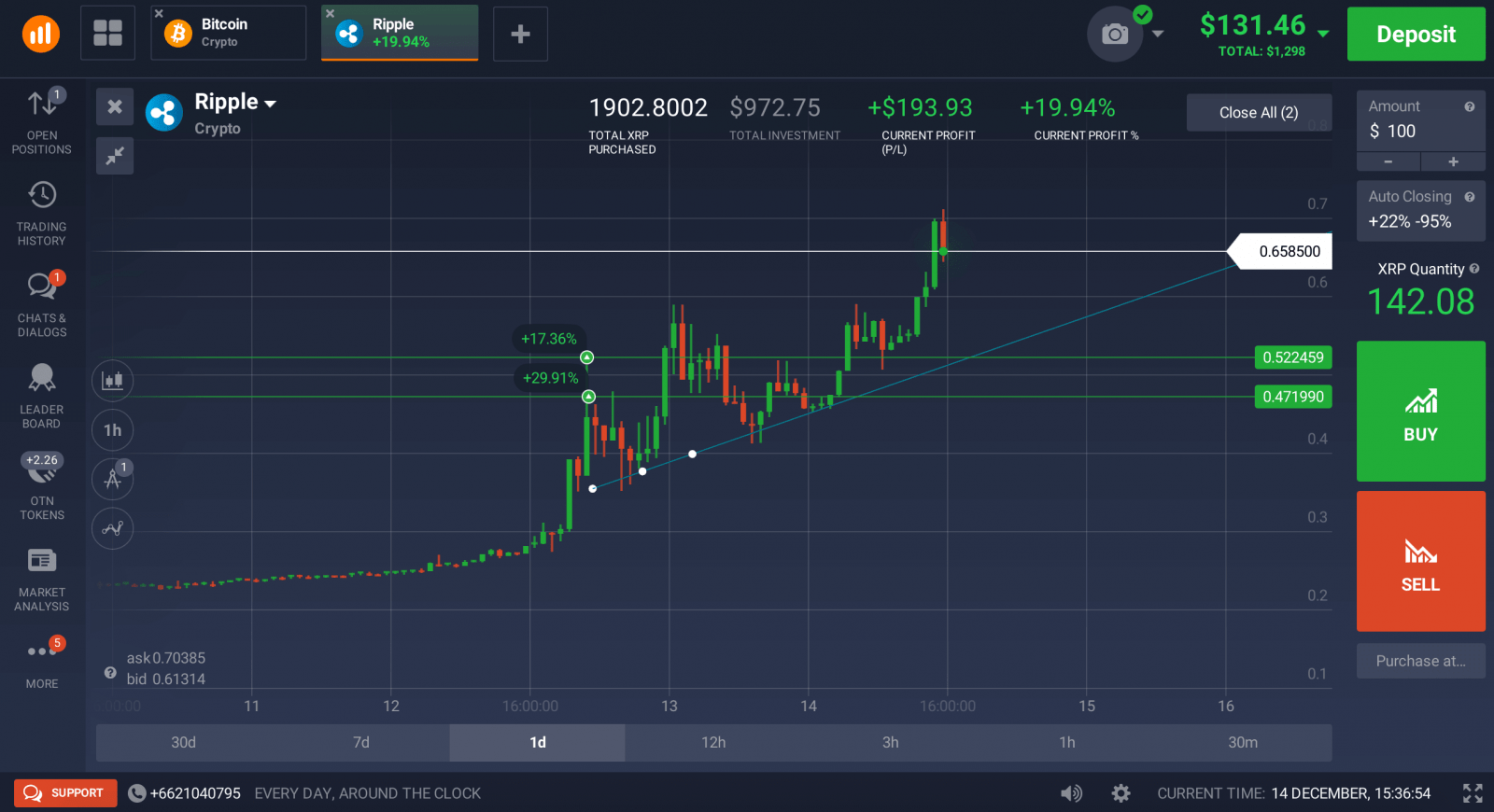Introduction
Imagine a world where you could predict the future fluctuations of currencies. While that might seem like a fantastical concept, currency option trading allows you to capitalize on those fluctuations, albeit with a certain level of risk. In recent years, the global currency market has become increasingly volatile, leading to a surge in interest in currency option trading. These options, like a contract that gives the buyer the right but not the obligation to buy a specific currency at a defined price, offer potential for significant profits, but also introduce the risk of substantial losses.

Image: www.bydfi.com
This article aims to demystify the world of currency option trading, walking you through its fundamentals, strategies, and complexities. We will explore how these options work, the different types available, and how you can navigate this dynamic market. Whether you are a seasoned investor looking to diversify your portfolio or a complete novice curious about this intriguing investment opportunity, this comprehensive guide will provide you with the insights you need to make informed decisions.
Understanding the Basics of Currency Options
Currency options are financial instruments that grant the holder the right, but not the obligation, to buy or sell a specific currency at a predetermined price (strike price) on or before a specific date (expiry date). These options are essentially contracts that allow investors to hedge against potential risks or speculate on future currency movements. Imagine you believe the value of the Euro will rise against the US Dollar. You could buy a call option, giving you the right to purchase Euros at a specific price. If the Euro appreciates, you can exercise your option, buying Euros at the lower strike price and selling them in the market at the higher current price, earning a profit.
There are two main types of currency options:
- Call options: Give the buyer the right to buy a currency at a certain price.
- Put options: Give the buyer the right to sell a currency at a certain price.
Currency options are traded on exchanges like the Chicago Mercantile Exchange (CME) or through over-the-counter (OTC) agreements between financial institutions. They are valuable for several reasons:
- Limited Risk: For a fixed premium, investors can control a much larger amount of currency than they would with a regular buy or sell order, limiting potential losses.
- Leverage: Options offer leverage, meaning a small investment in the option can yield significant returns. However, this leverage can also amplify losses.
- Flexibility: Investors can choose the strike price and expiry date that best suit their investment strategy.
Types of Currency Options and Their Uses
American vs. European Options
One key distinction in currency options is the exercise style. American options can be exercised anytime before the expiration date, while European options can only be exercised on the expiration date. This flexibility associated with American options comes at a higher premium compared to European options. The choice between American and European options depends on the investor’s trading style and risk tolerance.

Image: www.kingdavidsuite.com
Vanilla vs. Exotic Options
Beyond the basic call and put options, there are more complex options known as exotic options. These options have unique features and payoff structures, allowing investors to tailor their exposure to specific market scenarios.
For example, barrier options activate only if the underlying currency reaches a certain level. Digital options pay a fixed amount if the underlying currency reaches a specific price at expiry, regardless of the actual price. While these exotic options offer unique benefits, they come with higher complexity and require advanced understanding for effective utilization.
Factors Influencing Currency Option Prices
The price of a currency option, known as the premium, is determined by several factors, including:
- Spot price: The current market price of the underlying currency.
- Strike price: The price at which the option holder can buy or sell the currency.
- Time to expiration: The time remaining until the option expires. The longer the time, the more volatile the underlying currency, and the higher the option premium.
- Volatility: The expected movement of the underlying currency. Higher volatility leads to higher option premiums as the option becomes more valuable.
- Interest rates: Interest rate differentials between the two currencies can influence the option price.
Understanding the interplay of these factors is crucial for making informed trading decisions. The right combination of strike price, expiry date, and other parameters can significantly impact your potential profits or losses.
Strategies for Currency Option Trading
Currency option trading offers various strategies for investors based on their risk profile and market outlook. Some common strategies include:
- Covered call: Selling a call option on a currency you already own, generating income while limiting potential gains.
- Protective put: Buying a put option to protect a long position in a currency from declines in price.
- Straddle: Buying both a call and a put option on the same currency, anticipating significant price movements in either direction.
- Strangle: Similar to a straddle, but the call and put options have different strike prices, providing a higher potential reward with a higher risk than a straddle.
It’s important to remember that each strategy comes with its unique risks and rewards. Carefully evaluating your risk tolerance, market outlook, and desired outcome is crucial before implementing any strategy.
Risks Associated with Currency Option Trading
While currency option trading offers potential for significant profits, it also comes with inherent risks:
- Limited Profit Potential: For a call or put option, the maximum profit is limited to the premium paid. However, losses can exceed the initial investment.
- Time Decay: As time passes, the option premium decreases, known as time decay. This erosion can be significant, especially for options with short expiration periods.
- Volatility Risk: Option prices are sensitive to volatility. Unexpected price movements can lead to significant losses.
- Liquidity Risk: Getting into or out of a currency option position may be difficult if the market is illiquid, potentially leading to unfavorable prices.
Thorough research and a solid understanding of the risks involved are essential before entering the world of currency option trading.
Trends and Developments in Currency Option Trading
The currency option trading landscape is constantly evolving, influenced by factors like global economic conditions, geopolitical events, and technological advancements. Here are some highlights of recent trends:
- Increased use of technology: Trading platforms have become increasingly sophisticated, offering real-time data, advanced charting tools, and algorithmic trading capabilities. This has made currency option trading more accessible and efficient.
- Growth of exotic options: As investors seek more tailored strategies, exotic options have gained popularity, offering greater flexibility and potential for specific market scenarios.
- Focus on volatility: Volatility has become a key driver of currency option prices. Investors are employing options strategies to capitalize on or hedge against market uncertainty.
- Start small and learn: Begin with a small investment and focus on understanding the basics before venturing into complex strategies.
- Develop a trading plan: Define your goals, risk tolerance, and trading strategy before entering any trade.
- Manage your risk: Utilize stop-loss orders to limit potential losses, and avoid over-leveraging your positions.
- Stay informed: Monitor market trends, economic data, and geopolitical events that could impact currency movements.
- Seek professional guidance: Consider consulting with a financial advisor for customized advice tailored to your investment objectives.
Tips and Expert Advice
Here are some key tips for entering the world of currency option trading:
Remember, currency option trading requires patience, discipline, and a willingness to learn. Continuously refining your trading strategy, staying updated on market dynamics, and managing your risk effectively can lead to successful outcomes.
FAQ
Q: What is the minimum investment required for currency option trading?
A: The minimum investment varies depending on the brokerage and the specific option contract. Some brokers may require a minimum account balance, while others might only require a premium payment for the option contract.
Q: Are currency options suitable for everyone?
A: Currency options are not suitable for all investors. They involve significant risk and require a strong understanding of the underlying markets and trading strategies. It’s essential to assess your risk tolerance, financial situation, and trading experience before considering currency options.
Q: How can I learn more about currency options trading?
A: Numerous resources are available for learning about currency option trading. Educational websites, online courses, and books can provide a comprehensive understanding of the concepts and strategies involved. Additionally, consulting with a financial advisor can provide personalized guidance based on your individual needs.
Q: Are currency options regulated?
A: Yes, currency options trading is regulated by government agencies and exchanges. These regulations ensure market integrity and transparency, protecting investors from fraud and misconduct.
Currency Option Trading
Conclusion
Currency option trading can be an exciting and potentially lucrative investment opportunity, but it requires a clear understanding of the underlying principles, risks, and trading strategies. This article has provided a comprehensive overview of the topic, highlighting the key factors to consider and the essential steps to navigate this dynamic market. As you embark on your journey into the world of currency options, remember to start small, learn continuously, manage your risks, and seek professional guidance when needed.
Are you interested in exploring the world of currency option trading further? Leave a comment below and share your thoughts on this exciting investment arena.






